Laser Irradiation-Induced Nanoscale Surface Transformations in Strontium Titanate
Abstract
:1. Introduction
2. Materials and Methods
3. Results
4. Conclusions
Author Contributions
Funding
Institutional Review Board Statement
Informed Consent Statement
Data Availability Statement
Acknowledgments
Conflicts of Interest
References
- Rao, S.S.; Lee, Y.F.; Prater, J.T.; Smirnov, A.I.; Narayan, J. Laser annealing induced ferromagnetism in SrTiO3 single crystal. Appl. Phys. Lett. 2014, 105, 042403. [Google Scholar] [CrossRef]
- Chan, N.H.; Sharma, R.K.; Smyth, D.M. Nonstoichiometry in SrTiO3. J. Electrochem. Soc. 1981, 128, 1762. [Google Scholar] [CrossRef]
- Gerblinger, J.; Meixner, H. Fast oxygen sensors based on sputtered strontium titanate. Sens. Actuators B Chem. 1991, 4, 99–102. [Google Scholar] [CrossRef]
- Weber, W.J.; Zarkadoula, E.; Pakarinen, O.H.; Sachan, R.; Chisholm, M.F.; Liu, P.; Xue, H.; Jin, K.; Zhang, Y. Synergy of elastic and inelastic energy loss on ion track formation in SrTiO3. Sci. Rep. 2015, 5, 7726. [Google Scholar] [CrossRef] [PubMed]
- Xue, H.; Zarkadoula, E.; Sachan, R.; Zhang, Y.; Trautmann, C.; Weber, W.J. Synergistically-enhanced ion track formation in pre-damaged strontium titanate by energetic heavy ions. Acta Mater. 2018, 150, 351–359. [Google Scholar] [CrossRef]
- Toulemonde, M.; Weber, W.J.; Li, G.; Shutthanandan, V.; Kluth, P.; Yang, T.; Wang, Y.; Zhang, Y. Synergy of nuclear and electronic energy losses in ion-irradiation processes: The case of vitreous silicon dioxide. Phys. Rev. B 2011, 83, 054106. [Google Scholar] [CrossRef] [Green Version]
- Thomé, L.; Debelle, A.; Garrido, F.; Trocellier, P.; Serruys, Y.; Velisa, G.; Miro, S. Combined effects of nuclear and electronic energy losses in solids irradiated with a dual-ion beam. Appl. Phys. Lett. 2013, 102, 141906. [Google Scholar] [CrossRef]
- Sall, M.; Monnet, I.; Grygiel, C.; d’Etat, B.B.; Lebius, H.; Leclerc, S.; Balanzat, E. Synergy between electronic and nuclear energy losses for color center creation in AlN. EPL (Europhys. Lett.) 2013, 102, 26002. [Google Scholar] [CrossRef]
- Zhang, Y.; Aidhy, D.S.; Varga, T.; Moll, S.; Edmondson, P.D.; Namavar, F.; Jin, K.; Ostrouchov, C.N.; Weber, W.J. The Effect of Electronic Energy Loss on Irradiation-Induced Grain Growth in Nanocrystalline Oxides. Phys. Chem. Chem. Phys. 2014, 16, 8051–8059. [Google Scholar] [CrossRef]
- Wang, Y.Y.; Grygiel, C.; Dufour, C.; Sun, J.R.; Wang, Z.G.; Zhao, Y.T.; Xiao, G.Q.; Cheng, R.; Zhou, X.M.; Ren, J.R.; et al. Energy Deposition by Heavy Ions: Additivity of Kinetic and Potential Energy Contributions in Hillock Formation on CaF2. Sci. Rep. 2014, 4, 5742. [Google Scholar] [CrossRef] [Green Version]
- Debelle, A.; Backman, M.; Thomé, L.; Weber, W.J.; Toulemonde, M.; Mylonas, S.; Boulle, A.; Pakarinen, O.H.; Juslin, N.; Djurabekova, F.; et al. Combined Experimental and Computational Study of the Recrystallization Process Induced by Electronic Interactions of Swift Heavy Ions with Silicon Carbide Crystals. Phys. Rev. B 2012, 86, 100102. [Google Scholar] [CrossRef] [Green Version]
- Weber, W.J.; Zhang, Y.; Xiao, H.; Wang, L. Dynamic Recovery in Silicate-Apatite Structures under Irradiation and Implications for Long-Term Immobilization of Actinides. RSC Adv. 2012, 2, 595–604. [Google Scholar] [CrossRef]
- Pervolaraki, M.; Mihailescu, C.N.; Luculescu, C.R.; Ionescu, P.; Dracea, M.D.; Pantelica, D.; Giapintzakis, J. Picosecond Ultrafast Pulsed Laser Deposition of SrTiO3. Appl. Surf. Sci. 2015, 336, 278–282. [Google Scholar] [CrossRef]
- Sachan, R.; Chisholm, M.F.; Ou, X.; Zhang, Y.; Weber, W.J. Energetic Ion Irradiation-Induced Disordered Nanochannels for Fast Ion Conduction. JOM 2019, 71, 103–108. [Google Scholar] [CrossRef]
- Leino, A.A.; Samolyuk, G.D.; Sachan, R.; Granberg, F.; Weber, W.J.; Bei, H.; Liu, J.; Zhai, P.; Zhang, Y. GeV Ion Irradiation of NiFe and NiCo: Insights from MD Simulations and Experiments. Acta Mater. 2018, 151, 191–200. [Google Scholar] [CrossRef] [Green Version]
- Sachan, R.; Pakarinen, O.H.; Liu, P.; Patel, M.K.; Chisholm, M.F.; Zhang, Y.; Wang, X.L.; Weber, W.J. Structure and Band Gap Determination of Irradiation-Induced Amorphous Nano-Channels in LiNbO3. J. Appl. Phys. 2015, 117, 135902. [Google Scholar] [CrossRef]
- Gupta, A.K.; Arora, G.; Aidhy, D.S.; Sachan, R. ∑3 Twin Boundaries in Gd2Ti2O7 Pyrochlore: Pathways for Oxygen Migration. ACS Appl. Mater. Interfaces 2020, 12, 45558–45563. [Google Scholar] [CrossRef]
- Kan, D.; Terashima, T.; Kanda, R.; Masuno, A.; Tanaka, K.; Chu, S.; Kan, H.; Ishizumi, A.; Kanemitsu, Y.; Shimakawa, Y.; et al. Blue-Light Emission at Room Temperature from Ar+ -Irradiated SrTiO3. Nat. Mater. 2005, 4, 816–819. [Google Scholar] [CrossRef]
- Nova, T.F.; Disa, A.S.; Fechner, M.; Cavalleri, A. Metastable Ferroelectricity in Optically Strained SrTiO3. Science 2019, 364, 1075–1079. [Google Scholar] [CrossRef] [Green Version]
- Hanzig, J.; Abendroth, B.; Hanzig, F.; Stöcker, H.; Strohmeyer, R.; Meyer, D.C.; Lindner, S.; Grobosch, M.; Knupfer, M.; Himcinschi, C.; et al. Single Crystal Strontium Titanate Surface and Bulk Modifications Due to Vacuum Annealing Vacuum Annealing. J. Appl. Phys. 2011, 110, 064107. [Google Scholar] [CrossRef]
- Hill, N.A. Density Functional Studies of Multiferroic Magnetoelectrics. Annu. Rev. Mater. Sci. 2002, 32, 1–37. [Google Scholar] [CrossRef]
- Choi, H.J.; Park, S.W.; Han, G.D.; Na, J.; Kim, G.; Shim, J.H. Resistive Switching Characteristics of Polycrystalline SrTiO3 Films. Appl. Phys. Lett. 2014, 104, 242105. [Google Scholar] [CrossRef]
- Spurgeon, S.R.; Kaspar, T.C.; Shutthanandan, V.; Gigax, J.; Shao, L.; Sassi, M. Asymmetric Lattice Disorder Induced at Oxide Interfaces. Adv. Mater. Interfaces 2020, 7, 1901944. [Google Scholar] [CrossRef] [Green Version]
- Crespillo, M.L.; Graham, J.T.; Agulló-López, F.; Zhang, Y.; Weber, W.J. Role of Oxygen Vacancies on Light Emission Mechanisms in SrTiO3 Induced by High-Energy Particles. J. Phys. D Appl. Phys. 2017, 50, 155303. [Google Scholar] [CrossRef]
- Brovko, O.O.; Tosatti, E. Controlling the Magnetism of Oxygen Surface Vacancies in SrTiO3 through Charging. Phys. Rev. Mater. 2017, 1, 044405. [Google Scholar] [CrossRef] [Green Version]
- Cha, S.H.; Han, Y.H. Effects of Oxygen Vacancies on Relaxation Behavior of Mg-Doped BaTiO3. Jpn. J. Appl. Phys. 2006, 45, 7797. [Google Scholar] [CrossRef]
- Lu, W.; Song, W.; Yang, P.; Ding, J.; Chow, G.M.; Chen, J. Strain Engineering of Octahedral Rotations and Physical Properties of SrRuO3 Films. Sci. Rep. 2015, 5, 10245. [Google Scholar] [CrossRef] [Green Version]
- Frenkel, A.I.; Ehre, D.; Lyahovitskaya, V.; Kanner, L.; Wachtel, E.; Lubomirsky, I. Origin of Polarity in Amorphous SrTiO3. Phys. Rev. Lett. 2007, 99, 215502. [Google Scholar] [CrossRef]
- Joshi, P.C.; Krupanidhi, S.B. Structural and electrical characteristics of SrTiO3 thin films for dynamic random access memory applications. J. Appl. Phys. 1993, 73, 7627–7634. [Google Scholar] [CrossRef]
- Lu, S.G.; Zhu, X.H.; Mak, C.L.; Wong, K.H.; Chan, H.L.W.; Choy, C.L. High tunability in compositionally graded epitaxial barium strontium titanate thin films by pulsed-laser deposition. Appl. Phys. Lett. 2003, 82, 2877–2879. [Google Scholar] [CrossRef] [Green Version]
- Shenoy, U.S.; Bantawal, H.; Bhat, D.K. Band Engineering of SrTiO3: Effect of Synthetic Technique and Site Occupancy of Doped Rhodium. J. Phys. Chem. C 2018, 122, 27567–27574. [Google Scholar] [CrossRef]
- Domen, K.; Kudo, A.; Onishi, T. Mechanism of photocatalytic decomposition of water into H2 and O2 over NiO SrTiO3. J. Catal. 1986, 102, 92–98. [Google Scholar] [CrossRef]
- Hui, S.; Petric, A. Evaluation of Yttrium-Doped SrTiO3 as an Anode for Solid Oxide Fuel Cells. J. Eur. Ceram. Soc. 2002, 22, 1673–1681. [Google Scholar] [CrossRef]
- Verbraeken, M.C.; Ramos, T.; Agersted, K.; Ma, Q.; Savaniu, C.D.; Sudireddy, B.R.; Irvine, J.T.S.; Holtappels, P.; Tietz, F. Modified Strontium Titanates: From Defect Chemistry to SOFC Anodes. RSC Adv. 2015, 5, 1168–1180. [Google Scholar] [CrossRef] [Green Version]
- Ihrig, H.; Hengst, J.H.T.; Klerk, M. Conductivity-dependent cathodoluminescence in BaTiO3, SrTiO3 and TiO2. Z. Für Phys. B Condens. Matter 1981, 40, 301–306. [Google Scholar] [CrossRef]
- Lehuta, K. Dopant-Defect Engineering in Strontium Titanate-Based Materials. Ph.D. Thesis, University of Massachusetts, Amherst, MA, USA, 2017. [Google Scholar]
- Gupta, S.; Sachan, R.; Narayan, J. Scale-up of Q-carbon and Nanodiamonds by Pulsed Laser Annealing. Diam. Relat. Mater. 2019, 99, 107531. [Google Scholar] [CrossRef]
- Persson, K. Materials Data on SrTiO3 (SG:221) by Materials Project; OSTI: Oak Ridge, TN, USA, 2014. [CrossRef]
- Gupta, A.K.; Gupta, S.; Sachan, R. Laser Irradiation Induced Atomic Structure Modifications in Strontium Titanate. JOM 2022, 74, 143–150. [Google Scholar] [CrossRef]
- Plotkin-swing, B.; Corbin, G.J.; De Carlo, S.; Dellby, N.; Hoermann, C.; Hoffman, M.V.; Lovejoy, T.C.; Meyer, C.E.; Mittelberger, A.; Pantelic, R.; et al. Hybrid Pixel Direct Detector for Electron Energy Loss Spectroscopy. Ultramicroscopy 2020, 217, 113067. [Google Scholar] [CrossRef]
- Sachan, R.; Cooper, V.R.; Liu, B.; Aidhy, D.S.; Voas, B.K.; Lang, M.; Ou, X.; Trautmann, C.; Zhang, Y.; Chisholm, M.F.; et al. Forging Fast Ion Conducting Nanochannels with Swift Heavy Ions: The Correlated Role of Local Electronic and Atomic Structure. J. Phys. Chem. C 2017, 121, 975–981. [Google Scholar] [CrossRef]
- Sachan, R.; Zhang, Y.; Ou, X.; Trautmann, C.; Chisholm, M.F.; Weber, W.J. New Insights on Ion Track Morphology in Pyrochlores by Aberration Corrected Scanning Transmission Electron Microscopy. J. Mater. Res. 2016, 32, 928–935. [Google Scholar] [CrossRef]
- Aidhy, D.S.; Sachan, R.; Zarkadoula, E.; Pakarinen, O.; Chisholm, M.F.; Zhang, Y.; Weber, W.J. Fast Ion Conductivity in Strained Defect-Fluorite Structure Created by Ion Tracks in Gd2Ti2O7. Sci. Rep. 2015, 5, 16297. [Google Scholar] [CrossRef] [PubMed] [Green Version]
- Mandal, S.; Gupta, A.K.; Beavers, B.H.; Singh, V.; Narayan, J.; Sachan, R. Atomic-Scale Insights on Large-Misfit Heterointerfaces in LSMO/MgO/c-Al2O3. Crystals 2021, 11, 1493. [Google Scholar] [CrossRef]
- Li, Y.; Wang, Q.; An, M.; Li, K.; Wehbe, N.; Zhang, Q.; Dong, S.; Wu, T. Nanoscale Chemical and Valence Evolution at the Metal/Oxide Interface: A Case Study of Ti/SrTiO3. Adv. Mater. Interfaces 2016, 3, 1600201. [Google Scholar] [CrossRef]
- Dai, S.; Lu, H.; Chen, F.; Chen, Z.; Ren, Z.Y.; Ng, D.H.L. In-Doped SrTiO3 Ceramic Thin Films. Appl. Phys. Lett. 2002, 80, 3545–3547. [Google Scholar] [CrossRef]
- Akhtar, M.J.; Akhtar, Z.U.N.; Jackson, R.A.; Catlow, C.R.A. Computer Simulation Studies of Strontium Titanate. J. Am. Ceram. Soc. 1995, 78, 421–428. [Google Scholar] [CrossRef]
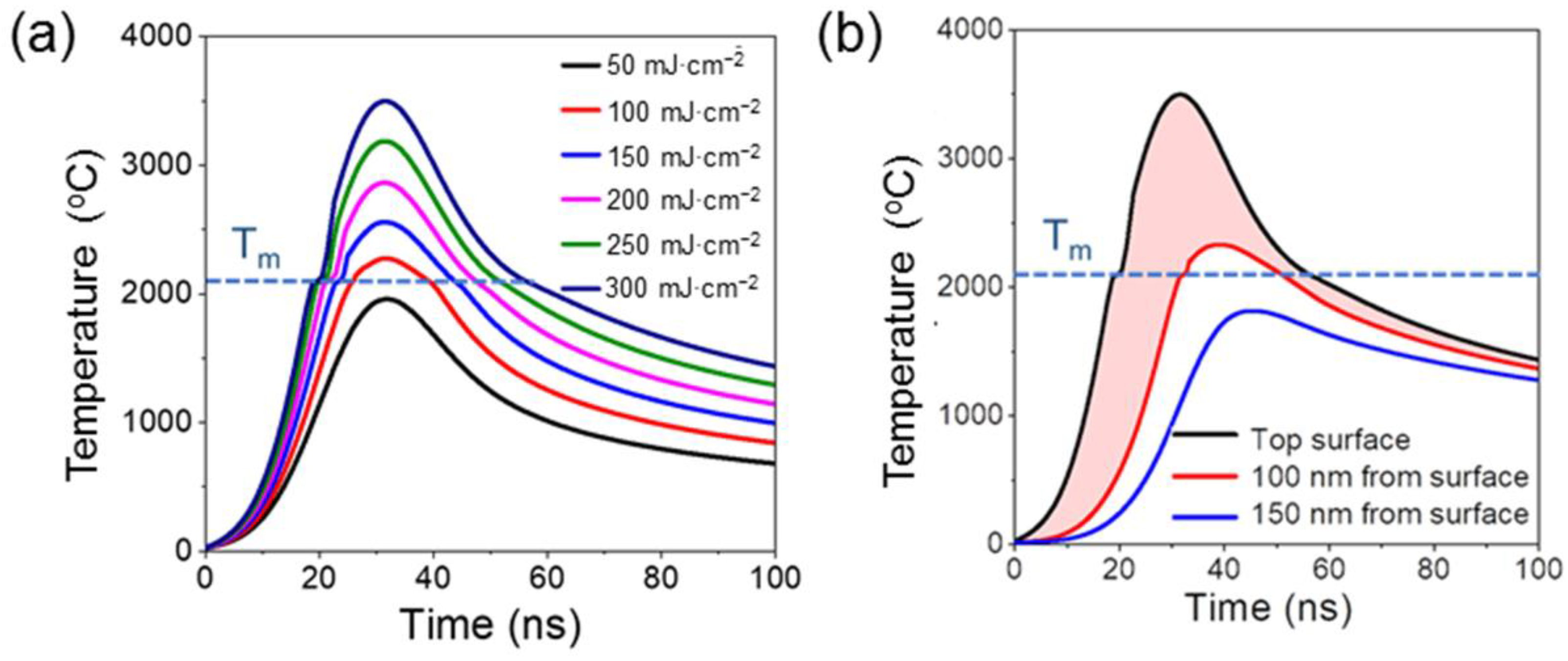
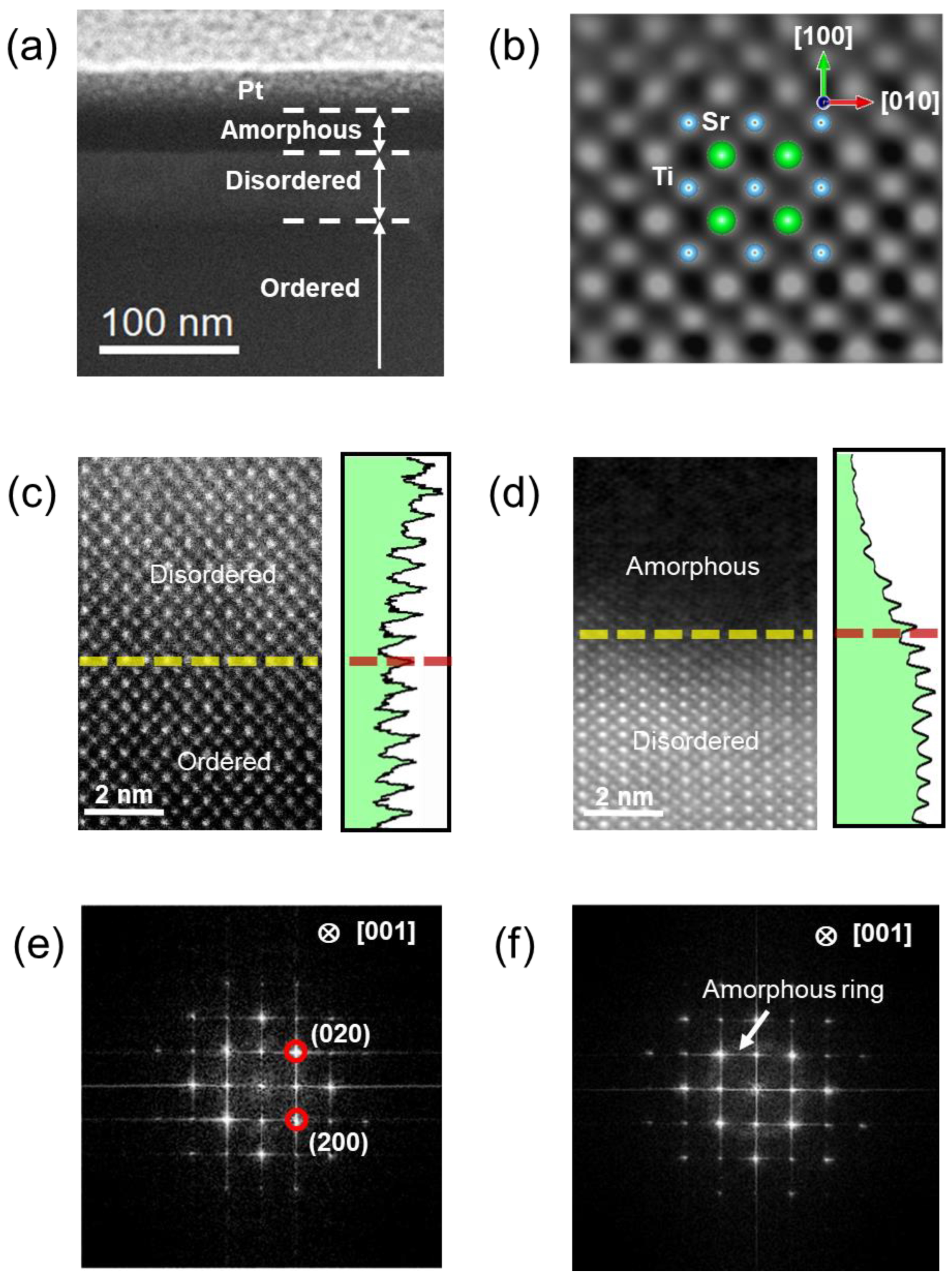
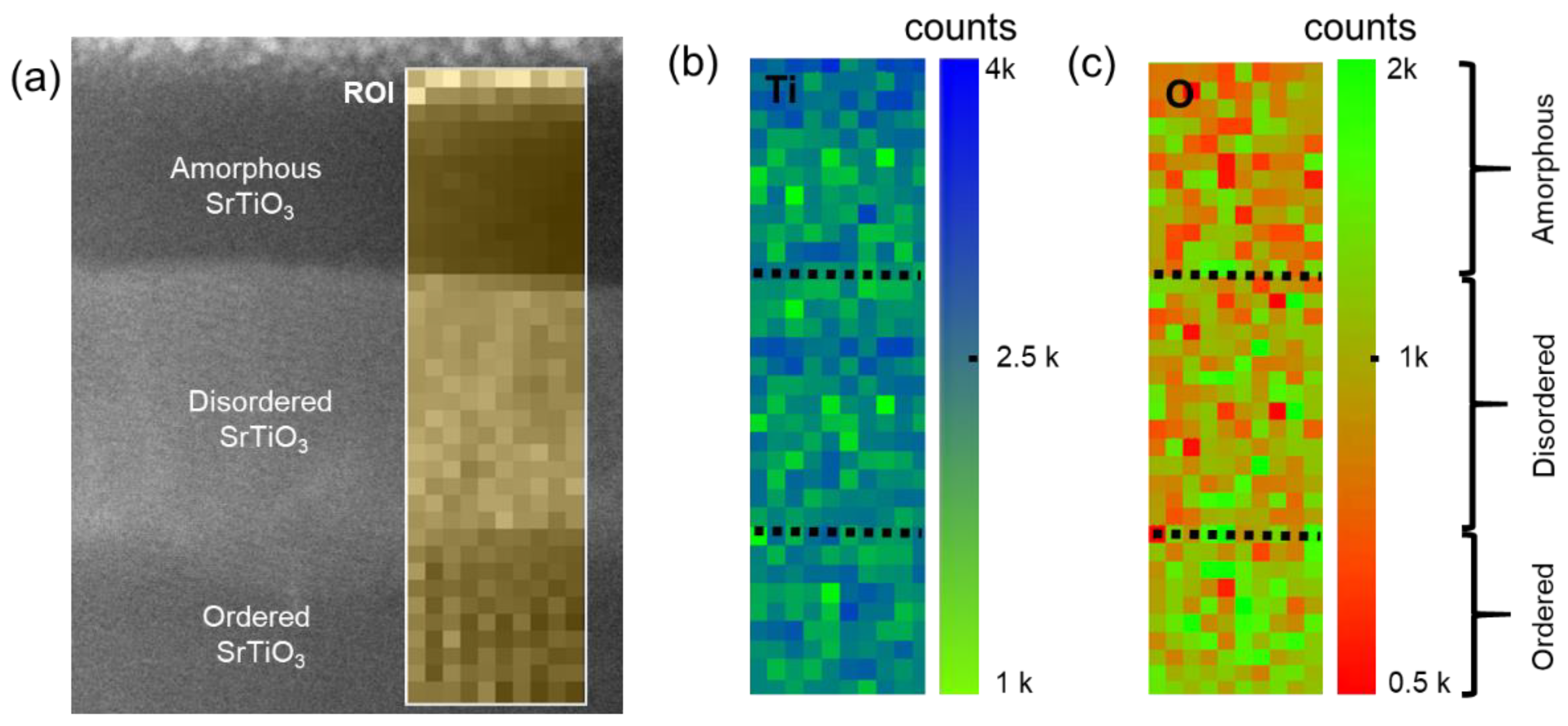
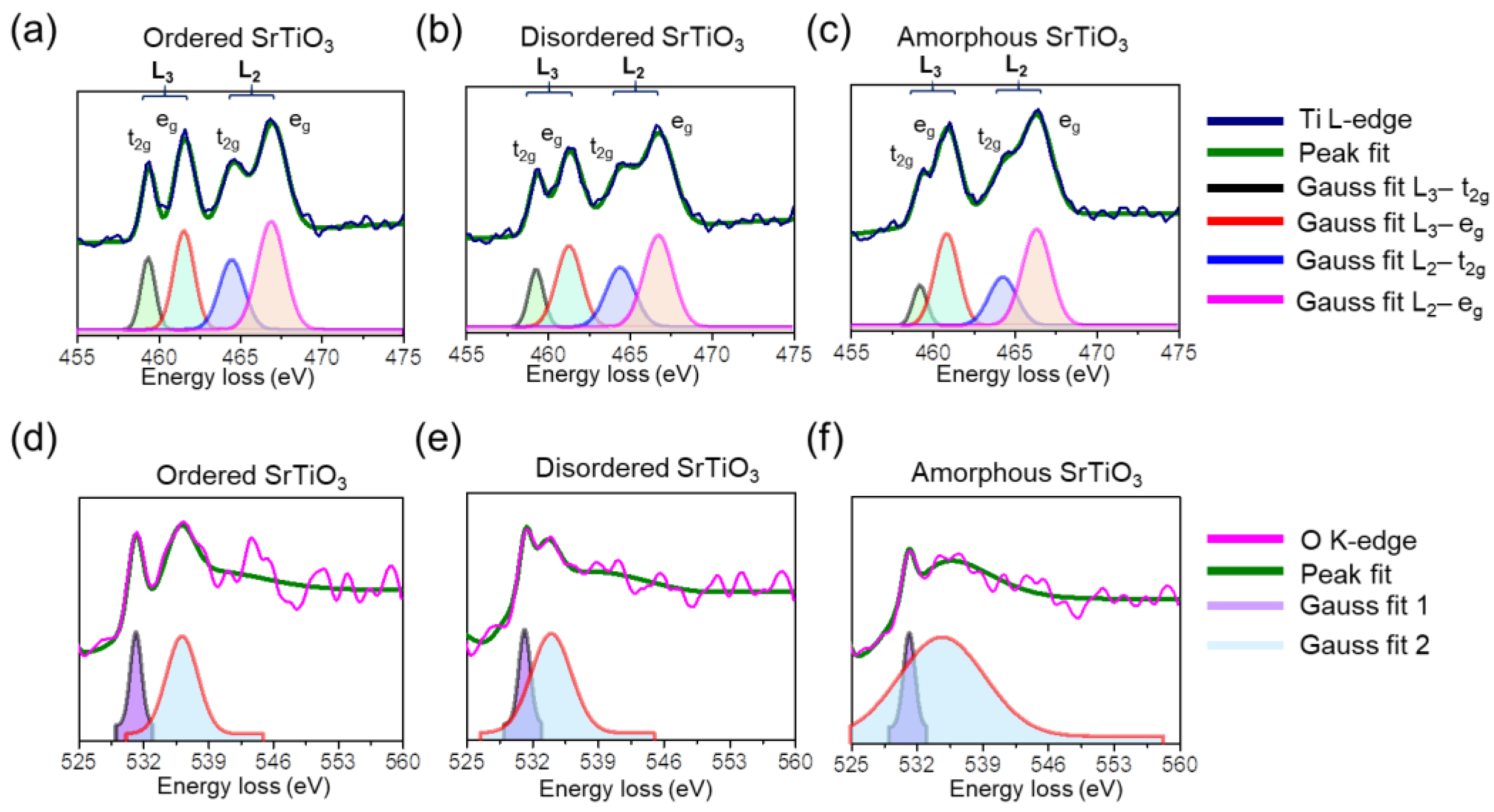
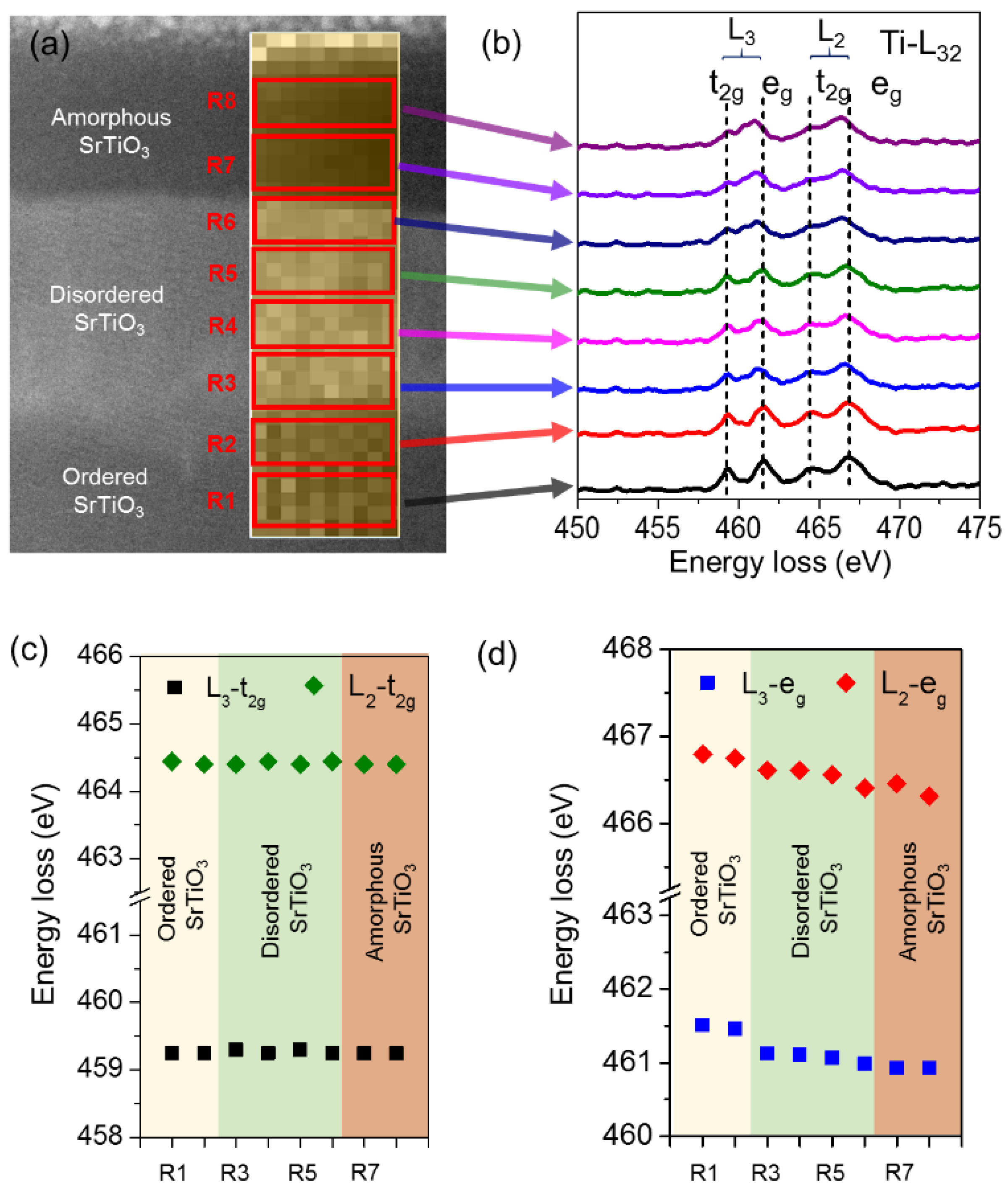
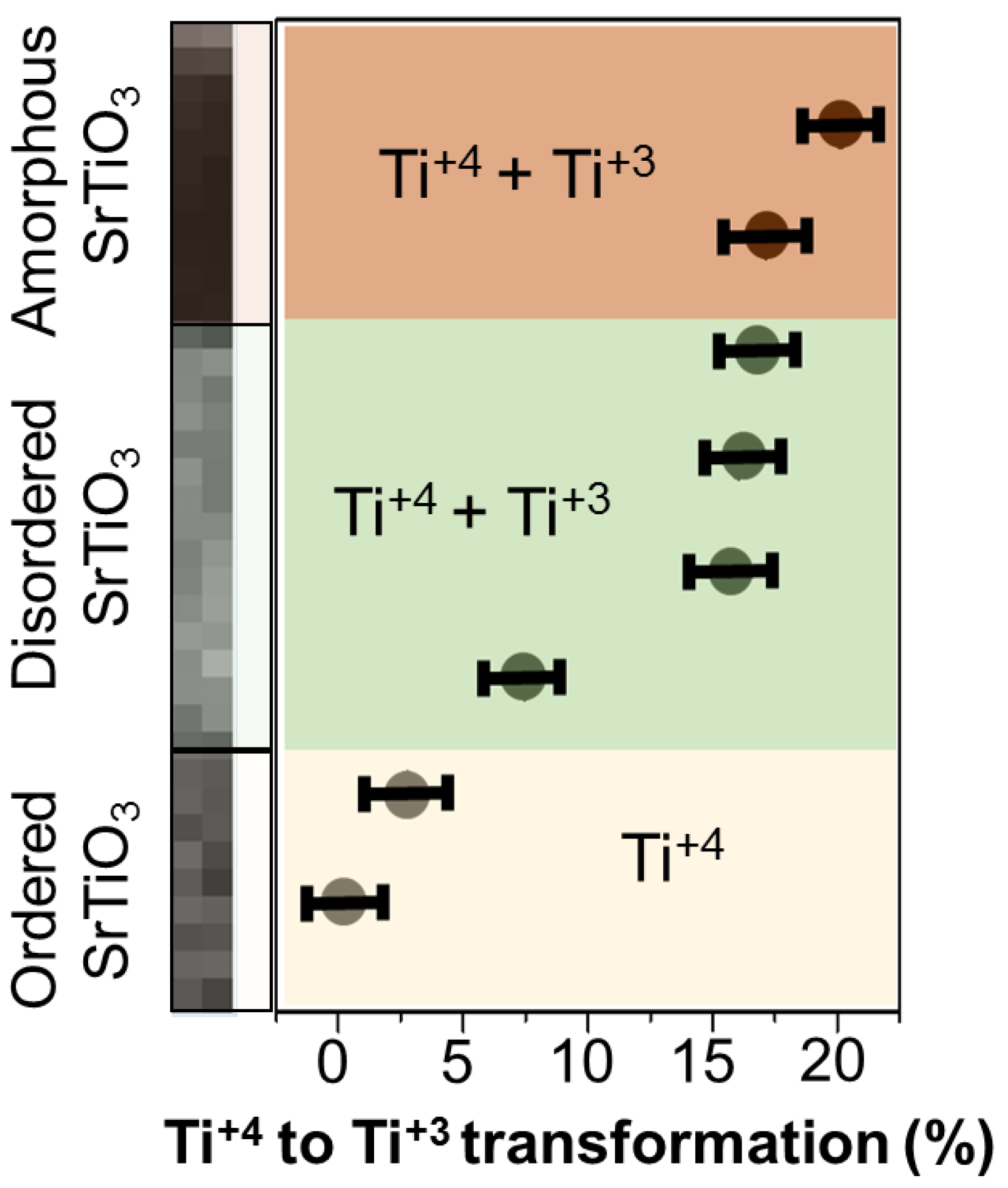
Publisher’s Note: MDPI stays neutral with regard to jurisdictional claims in published maps and institutional affiliations. |
© 2022 by the authors. Licensee MDPI, Basel, Switzerland. This article is an open access article distributed under the terms and conditions of the Creative Commons Attribution (CC BY) license (https://creativecommons.org/licenses/by/4.0/).
Share and Cite
Gupta, A.K.; Gupta, S.; Mandal, S.; Sachan, R. Laser Irradiation-Induced Nanoscale Surface Transformations in Strontium Titanate. Crystals 2022, 12, 624. https://doi.org/10.3390/cryst12050624
Gupta AK, Gupta S, Mandal S, Sachan R. Laser Irradiation-Induced Nanoscale Surface Transformations in Strontium Titanate. Crystals. 2022; 12(5):624. https://doi.org/10.3390/cryst12050624
Chicago/Turabian StyleGupta, Ashish Kumar, Siddharth Gupta, Soumya Mandal, and Ritesh Sachan. 2022. "Laser Irradiation-Induced Nanoscale Surface Transformations in Strontium Titanate" Crystals 12, no. 5: 624. https://doi.org/10.3390/cryst12050624
APA StyleGupta, A. K., Gupta, S., Mandal, S., & Sachan, R. (2022). Laser Irradiation-Induced Nanoscale Surface Transformations in Strontium Titanate. Crystals, 12(5), 624. https://doi.org/10.3390/cryst12050624






